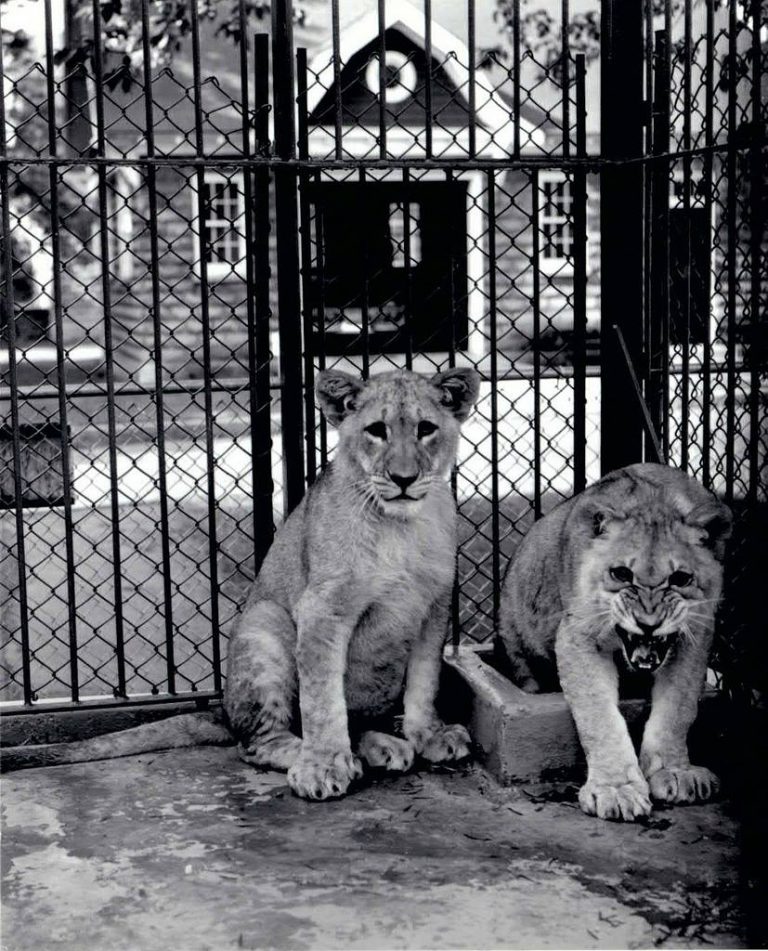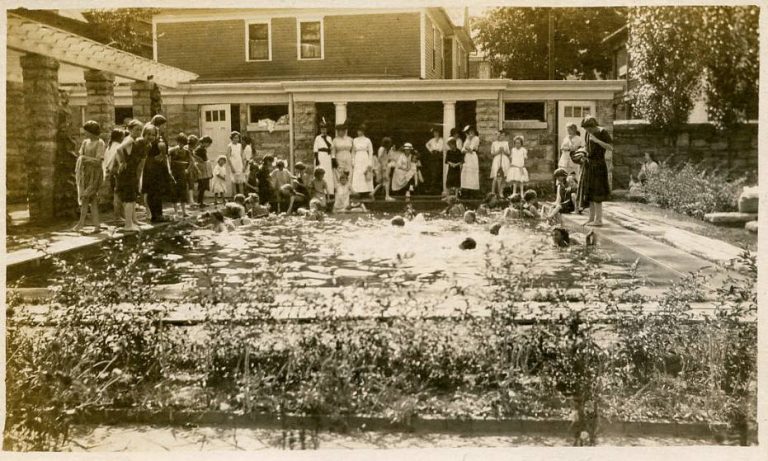The Thompson Park Zoo: A Look Back At The Turning Point Toward Natural Habitation In The Early 1980s
Nearly two decades after Thompson Park was opened to the public, the Thompson Park Zoo was created in 1920 when Northern New York Trust donated two white-tailed deer to the park. Per the zoo’s official website, “The goal was to create a naturalistic exhibit that would offer its visitors an opportunity to enjoy the grace and beauty of these indigenous animals.”

The idea of the zoo at Thompson Park, then City Park, began in 1916 when a former Watertown attorney, aptly named George A. Lawyer, suggested a zoo at the park would be a great attraction. It wouldn’t be until 1920, though, that action was taken. One of the first animals was “Bucko,” a three-month-old Canadian black bear cub. Public support for the zoo was strong, and surprisingly The Park Zoo club, with members ranging from 6 to 12 years of age, was founded in 1920 with Rollin J. Fairbanks, 12, as one of its organizers. They would raise funds and purchase a number of animals for the zoo.
The zoo wouldn’t be without controversy in its early days. In 1930, a feeder was killed in the bear cage, making national news—
WATERTOWN, N.Y., June 2 — An enraged female black bear whose cubs recently had been taken away from her, killed her feeder, Emerson E. Joyce, 60, at the John C. Thompson Park zoo here Monday.
So ferocious was her attack that none dared go to the assistance of Joyce in his death battle. The bear dragged Joyce’s body into an artificial cave so that only his feet were visible.
Police later recovered the body, badly crushed and with the neck broken. The bear weighed 500 pounds.
The story would have variations from newspaper to newspaper. Still, locally, the Watertown Daily Times stated it was a 350 lbs bear with no witnesses and that the superintendent of the park would shoot at the bear twice, hitting it once in the head. Badly wounded, it would retreat to its cave. Mr. Joyce was retrieved but died en route to Mercy Hospital. The bear said never to have shown any signs of viciousness, was allowed to live, and Mr. Joyce’s widow would be compensated $8.40/week for the rest of her life. There was no mention of the bear having had cubs taken from her.
1982 and Death of Lion “Tim” Spark The Seeds of Change
While the Thompson Park Zoo has undergone a number of changes in its 100+ years of operations, the original intent wasn’t always the focus. In the early 1980s, the zoo faced criticism after the death of its beloved lion, Tim, who had spent all but a few months of his life in anything but a naturalistic exhibit. At the time of his euthanasia in 1982, Tim was believed to have been the oldest lion in captivity at 21 years of age. Having lost weight over the course of the previous six months, an autopsy was performed on Tim, and cancer was discovered throughout many of his organs.

Tim had come to the park in August of 1960 from the Columbus Zoo in Ohio, where he was born a few months earlier. He would join Kim, who arrived earlier in Watertown with another lioness who was part of the exchange for Tim. They would replace the previous lion and lioness, Jack and Jill, who lived relatively short lives in captivity by today’s standards.
After Tim’s death in 1982, there would be some reluctance to replace him with another cub due to the zoo’s cramped quarters. One particular letter to the editor in the Watertown Daily Times on July 26, 1982, would exemplify the criticism–
If wild creatures must be forced into an artificial environment, that environment should duplicate the real one as best as possible. The Park Safari or San Diego Zoo concepts at least give their inhabitants a degree of respect and freedom. We feel the cramped quarters of the Thompson Park Zoo constituted cruel and unnecessary treatment for “Tim.” It is another instance of man abusing the harmony of nature for his own amusement and profit.
Please understand no accusations are being made at anyone at the zoo. Our only concern is for the creatures who might wind up imprisoned in the inadequate facilities for no apparent reason.
Michael T. and Kristy Russell, Marcia Fields

In October of 1982, the Thompson Park Zoo would accept two new cubs donated once again by the Watertown Lions Club, later named “Duke” and “Duchess,” but the direction of the zoo was still a question of concern with some pointing to the proposed study by the Utica Zoo director to seek what direction it should take. Meanwhile, even the zoo’s superintendent, Robert Reid, preferred to see the facilities improved prior to obtaining new cubs. Shortly thereafter, a “Help the Zoo” organization was established with the goal of raising $800,000 to erect a large mammal display area with natural habitat.
The controversy would, unfortunately, continue as Duchess would require her tail to be amputated after it was either bitten or clawed by a 5-year-old cougar in a neighboring cage when Duchess backed into the area between her cage and the cougar’s, which was actually one of the previous lion’s quarters. Not long after, Duke would require surgery for a mangled paw and broken left front leg after apparently getting it stuck inside the cage and trying to pull it loose.
Criticism would mount the following year as Duke and Duchess, both occupying a single lion cage while the cougar occupied the other, were fast approaching a time when it wouldn’t be practical to hold both. It was also a deficiency noted by a federal inspector during a recent visit and who was expected to return the following year, putting more pressure on changing the zoo’s environment.

The study, completed in the fall of 1983, would recommend the city charge an admission fee to the Thompson Park Zoo, create a zoo master plan, hire a full-time superintendent, and install a fence around the zoo’s perimeter. The report would cite no issues with the management, stating it to be “remarkably stable and orderly” despite its limited budget and physical plant problems.
In June of 1984, the Thompson Park Zoo was ordered to fix problems. According to an article in the Watertown Daily Times dated June 29–
Dr. A. E. Woods, inspector for the U.S. Department of Agriculture, has given the city until November 21 to double the size of the lion cages.
Dr. Woods also has directed that a perimeter fence be built around the entire zoo, with work to start by Oct. 21 and to be completed by Jun 21, 1985.
Since the zoo accepted the donation of the pair of lion cubs from the Lions Club in 1982, it has been recognized that the lion cages would have to be expanded.
With the zoo’s cougar in one of the two lion cages, the two cubs’ quarters in the remaining cage have become even more cramped as the cubs have grown.

Glacially-Paced Changes
In late October of 1985, the director of the Burnet Park Zoo, David Raboy, told the city council that the Thompson Park Zoo needed an overhaul, with approximately 80% of its animals, including monkeys, eliminated and replaced with creatures more suitable to a North Country facility. If this couldn’t be done, the alternative was to close the zoo.
One of the proposal’s major recommendations is an “open range” method of exhibiting. A major portion of the zoo is dedicated to natural habitats for elk, moose, mountain lions, and other large animals. “If you take animals and lock them in cubicles of steel and concrete, you have harmed those species and the citizens,” Mr. Raboy would tell the Daily Times in an article dated October 8, 1985. The article included the first glimpse of a master plan that somewhat resembles the Thompson Park Zoo as it is today.

After complaints from the Humane Society in 1986, the city would unveil plans that would address approximately $500K-$1M of the proposed $5M master plan. The plan would include improved quarters for the lions and the proposed education center. The city council, however, would hold off approval, waiting to see if other funding means would develop.
In 1987, the city of Watertown feared the Thompson Park Zoo might close for good as its efforts to receive approval for fencing were caught up in bureaucratic red tape. By the fall, they would finally be able to move ahead with the installation of the fence. Still, issues continued to pressure the city’s plans as the zoo faced national and international criticism in 1988.
Four years after being told major changes were needed, the only actions taken were: the creation of a committee; the mailing of surveys; and a public meeting, all resulting in the Thompson Park Zoo Advisory Committee recommending major changes, which were as follows per the March 25, 1989, Watertown Daily Times:
–To charge admission fees that would be used to maintain the zoo;
–That the city council determine a target amount in planning the total cost of the –project and explore all possible avenues of funding, including grants, loans, bonds, and tax income;
–That “No design or construction be undertaken except as a total package for the entire Zoo;
–That Jefferson County government assume a share of funding, and
–That the city hire a professional to coordinate improvement efforts.
In short, it took the better part of 4 to 6 years, more studies, more dollars, and countless criticism from around the world to heed the recommendations made in 1983 and 1985.

In September of 1989, the Watertown City Council finally made a decision.
Based on previous recommendations and that of its then veterinarian Dr. David Plant, the Thompson Park Zoo would give up exotic animals, including monkeys and lions. The lions, Duke and Duchess, would go to a private zoo in Ohio, and the monkeys would be shipped to a non-profit sanctuary in Texas the following year. In contrast, other “surplus” animals, including deer and elk, would go to the Burnet Park Zoo in Syracuse.
At the end of October 1989, the Watertown city council made a second decision.
According to the Daily Times, $700,000 was approved for the renovation of the Thompson Park Zoo into a “natural habitat wildlife park” with “a distinctively Adirondack theme.” As the Times reported–
It was the first major decision since the release of a master plan in 1985 recommending a $4-million-plus renovation. Guided by a practical-minded Zoo Advisory Committee, the city is taking the first steps in that plan.
The fate of the zoo that had seen few improvements since it opened in 1920 was made in a one-hour session Monday night between councilmen and the zoo panel.
Still, it would be another two years for the Watertown City Council to actually hire an architectural firm and approve plans for the renovation. On October 8, 1991, The Daily Times reported–
Thompson Park Conservancy Chairman and veterinarian David M. Plante said he was “elated” that the debate on whether to renovate the Thompson Park Zoo was over, but judging by the look on his face, it was more a sense of relief he felt.
After five years, the Watertown City Council Monday night officially decided to undertake a zoo renovation that Dr. Plante said could be the first step in making it a world-class facility.
“We’re elated at this point,” Dr. Plante said. “It’s fantastic. We’ve gone through literally years of being shot down again and against and we hung in there. This is an important project for Watertown. The council tonight showed leadership and a vision for the future of Watertown.”
In 1992, the Thompson Park Zoo would become a federal not-for-profit entity and the public would get its first views of its renovation the following year during Memorial Day Weekend.
Zoo New York
Since then, the zoo changed its name first to the New York Zoo at Thompson Park, then again in 2020 to Zoo New York, and has undergone numerous expansions to become the second most visited attraction in the Thousand Islands region.
Today, the zoo prides itself as being the only zoo in the world to exhibit species native to New York State, including elk, bald eagles, bears, wolverines, and more, while averaging about 50,000 visitors a year and, according to its website, “is supported by over 800 member households and reaches nearly 10,000 people through educational programs.”
Be sure to check out the rest of Thompson Park while you’re here! Listings have recently been updated with more photos
Winifred J. Dushkind
Working behind the scenes, and often in the news, on many of the events noted above was Winifred J. Dushkind, a former social worker, environmental supporter and animal activist, who worked tirelessly to help improve conditions at the Thompson Park Zoo. Winifred passed away in 2010 and the Watertown Daily Times took the opportunity to recognize her efforts in the article published in their November 18, 2010 edition, written by reporter Sarah Haas–
Zoo Officials Mourn Animal Advocate’s Death
Winifred J. Dushkind, 81, an avid supporter of the environment and an advocate for animal rights, died Tuesday. Mrs. Dushkind dedicated her life to protecting the rights and ensuring humane treatment of animals at the New York State Zoo at Thompson Park.
‘She was an untiring, clear-minded advocate for the animals who was not afraid, not intimidated and not put off by anyone,’ said John Scott Foster, the zoo’s departing executive director. ‘It seemed to me, in the kindest way possible, she had a little bit of hippie lurking in her. She was the person who spoke up and helped put in motion the changes that made the beautiful zoo we have today.’
As president and founder of a grassroots organization called Help the Zoo, Mrs. Dushkind pressured city officials to make improvements to the zoo in the late 1980s, especially in the lions’ cage.
When T. Urling Walker was the mayor of Watertown, he said he worked closely with Mrs. Dushkind on improving the conditions of the zoo.
‘Early on, Winifred Dushkind was the engine driving the improvements of animals at the zoo,” he said. “None of us knew that the conditions of the animals were not good. Her main thrust was to make sure we recognized the problems at the zoo and she made sure something was done about them. And we listened.’
Improvements began with the lions and continued until the zoo was a place people wanted to go.
‘It used to be a 15-foot by 15-foot concrete box,’ Mr. Foster said about the lions’ cage. ‘The zoo was not a good place for the animals or the people who were coming here.’Mrs. Dushkind never gave up on her cause. She wrote numerous letters to the editor to call out city officials or to defend her stance on an issue.
‘Basically, she made sure that the lives and the well being of the animals were not swept under the carpet,’ Mr. Foster said. ‘She didn’t allow the public to turn a blind eye. She kept people’s attention on the zoo. If she had not been so vocal you would have seen the zoo simply fade away.’


























